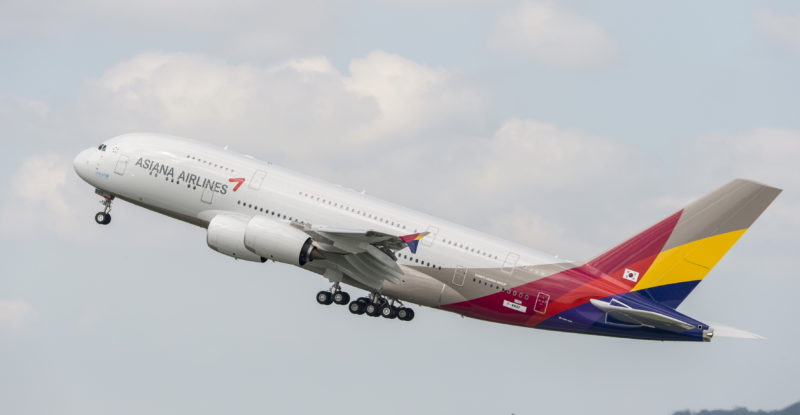Aviation-industry insiders, including commercial pilots and aviation safety experts, are puzzled why the pilots of an Asiana Airlines Airbus A380 operating a Los Angeles-Seoul flight on 27 September chose to return to Los Angeles rather than diverting to a much closer suitable alternate airport upon receiving a cargo-hold smoke alert far out in oceanic airspace.
Operating flight OZ201, the A380 – registered HL7626 – was carrying 353 people. It took off from Los Angeles International Airport (IATA code LAX) at 12:53 p.m. local time. The aircraft had been in the air for 3hr 17min, was cruising at 36,000 feet and was in international oceanic airspace 1,460nm north-northwest of LAX when the pilots received the cargo-hold smoke alert.
When the pilots received the alert of a potential fire onboard, the A380 was 710nm southwest of Anchorage International Airport and 840nm northwest of Vancouver International Airport. The A380 was also closer to at least four other international airports capable of landing A380s – Whitehorse International Airport, Seattle-Tacoma International Airport, Portland International Airport and San Francisco International Airport – than it was to LAX.
“Of all the issues affecting an aircraft in flight, a fire aloft is the worst,” says Robert Mark, a former airline pilot and aviation safety expert who is also an aviation educator, author, broadcaster and publisher of the Jetwhine blog. “Nobody wants to run the risk [of remaining aloft longer than necessary] unless they’re sure” there is no fire onboard.
Asiana suggests the pilots were sure. In a statement to Runway Girl Network, a spokesperson said:
Three hours after takeoff, the smoke alert appeared on the cockpit so the crew immediately activated the in-flight fire extinguisher system in cargo compartment. These safety measures, stipulated in the manual, were reported to be implemented in a timely manner.
After this, the signal turned off AT ONCE with no physical, visual or additional instrumental sign of any fire (no emergency). However, the crew decided to divert to LAX, its origin, to ensure flight safety and to conduct thorough and extensive investigation of the aircraft.
After landing, ground staff found no evidence of smoke or fire as reported and concluded that the overheated heating system in cargo compartment caused the alert.
Standard operating procedure in the event of a cargo-hold smoke alarm is to land as soon as possible. If pilots confirm a fire has broken out in a cargo hold inflight, then they must activate the hold’s fire suppression system, a procedure Asiana says its pilots executed. This action closes the hold’s ventilation valves and releases inert halon gas to reduce the concentration of oxygen in the hold’s air so it cannot support the propagation of fire.
Mark reckons the only reason the pilots might have chosen to return the A380 to LAX – a journey which took 3hr 35min, according to FlightAware tracking data – is that on determining everything was “sort of OK” they needed to go back to LAX to allow Asiana to inspect the aircraft.
But industry observers remain puzzled as to why Asiana didn’t land sooner. If the cargo compartment heating system was indeed overheating, as Asiana states, then would there not have been a continued risk of a fire breaking out in the cargo hold even after the crew activated the hold fire-extinguishing system? If that heating system continued to operate and overheat all the way back to LAX then would the risk of a fire not have been amplified by the amount of time (3 hours 35 minutes) the aircraft remained in the air on its way back to LAX? We sought but have yet to receive follow-up comment from Asiana.
Upon hearing that Asiana revealed it found the aircraft’s cargo compartment heating system had overheated, Mark says, “That makes me question the pilots’ judgment even more. It makes me all the less patient why they wouldn’t land at Anchorage,” rather than return to LAX. That decision leads Mark to add, “I don’t know any pilots who would have done that.” A bevy of commenters on The Aviation Herald (AvHerald) airline safety news site would seem to agree.
 The A380 landed at LAX nearly seven hours after it had taken off from there. A thorough inspection of its cargo hold revealed no signs of smoke or flames. It remained on the ground for more than 12 hours and then departed on a successful non-stop flight to Seoul.
The A380 landed at LAX nearly seven hours after it had taken off from there. A thorough inspection of its cargo hold revealed no signs of smoke or flames. It remained on the ground for more than 12 hours and then departed on a successful non-stop flight to Seoul.
Neither the FAA nor the NTSB will investigate the incident. “It’s not a US air carrier, not a US-designed aircraft, it did not happen in the US, and it does not meet the ICAO definition of an accident or even a ‘serious incident’,” an FAA spokeswoman tells RGN. “The United States would have no authority to investigate, as per ICAO. ICAO Annex 13 says that the State of Occurrence leads the investigation, and in the case of international waters, the State of Registry leads.”
This means any investigation of the Asiana A380 incident would be performed by the Korea Office of Civil Aviation, South Korea’s civil aviation authority.
Additional reporting by Mary Kirby









